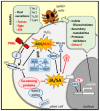Plant Defenses Against Tetranychus urticae: Mind the Gaps
- PMID: 32272602
- PMCID: PMC7238223
- DOI: 10.3390/plants9040464
Plant Defenses Against Tetranychus urticae: Mind the Gaps
Abstract
The molecular interactions between a pest and its host plant are the consequence of an evolutionary arms race based on the perception of the phytophagous arthropod by the plant and the different strategies adopted by the pest to overcome plant triggered defenses. The complexity and the different levels of these interactions make it difficult to get a wide knowledge of the whole process. Extensive research in model species is an accurate way to progressively move forward in this direction. The two-spotted spider mite, Tetranychus urticae Koch has become a model species for phytophagous mites due to the development of a great number of genetic tools and a high-quality genome sequence. This review is an update of the current state of the art in the molecular interactions between the generalist pest T. urticae and its host plants. The knowledge of the physical and chemical constitutive defenses of the plant and the mechanisms involved in the induction of plant defenses are summarized. The molecular events produced from plant perception to the synthesis of defense compounds are detailed, with a special focus on the key steps that are little or totally uncovered by previous research.
Keywords: Tetranychus urticae; constitutive and inducible defenses; mite counter-defenses; plant defense; signalling events.
Conflict of interest statement
The authors declare no conflict of interest
Figures


References
-
- Kant M.R., Jonckheere W., Knegt B., Lemos F., Liu J., Schimmel B.C.J., Villarroel C.A., Ataide L.M.S., Dermauw W., Glas J.J., et al. Mechanisms and ecological consequences of plant defense induction and suppression in herbivore communities. Ann. Bot. 2015;115:1015–1051. doi: 10.1093/aob/mcv054. - DOI - PMC - PubMed
Publication types
Grants and funding
LinkOut - more resources
Full Text Sources

